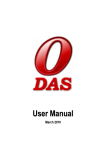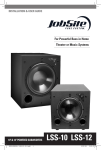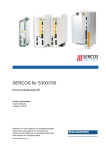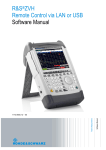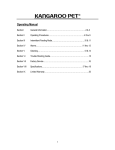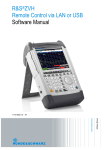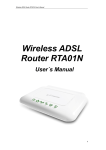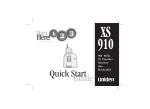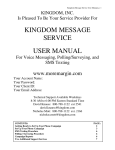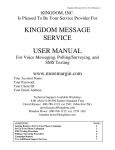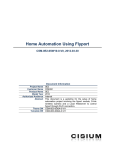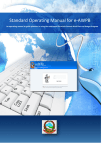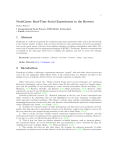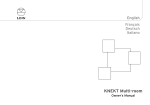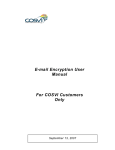Download Distributed Web Interface for Real-Time Spatial Audio Reproduction
Transcript
UNIVERSITÄT ROSTOCK
Distributed Web Interface
for Real-Time Spatial
Audio Reproduction
System
SoundScape Renderer
Héctor Daniel Villacián Ibáñez
Proyecto
Tema: Distribución de un programa de rendering de audio en tiempo real
Título: Distributed Web Interface for Real-Time Spatial Audio Reproduction System
Autor: Héctor Daniel Villacián Ibáñez
Titulación: Telemática
Centro de Lectura: Elektrotechnik
Tutor: Sascha Spors
Departamento: Nachrichtentechnik
Fecha de lectura: 16 de abril de 2013
Resumen
SSR es el acrónimo de SoundScape Renderer (tool for real-time spatial audio reproduction
providing a variety of rendering algorithms), es un programa escrito en su mayoría en C++. El
programa permite al usuario escuchar tanto sonidos grabados con anterioridad como sonidos
en directo. El sonido o los sonidos se oirán, desde el punto de vista del oyente, como si el
sonido se produjese en el punto que el programa decida, lo interesante de este proyecto es
que el sonido podrá cambiar de lugar, moverse, etc. Todo en tiempo real.
Esto se consigue sin modificar el sonido al grabarlo pero sí al emitirlo, el programa calcula las
variaciones necesarias para que al emitir el sonido al oyente le llegue como si el sonido
realmente se generase en un punto del espacio o lo más parecido posible. La sensación de
movimiento no deja de ser el punto anterior cambiando de lugar.
La idea era crear una aplicación web basada en Canvas de HTML5 que se comunicará con esta
interfaz de usuario remota. Así se solucionarían todos los problemas de compatibilidad ya que
cualquier dispositivo con posibilidad de visualizar páginas web podría correr una aplicación
basada en estándares web, por ejemplo un sistema con Windows o un móvil con navegador.
El protocolo debía de ser WebSocket porque es un protocolo HTML5 y ofrece las “garantías”
de latencia que una aplicación con necesidades de información en tiempo real requiere. Nos
permite una comunicación full-dúplex asíncrona sin mucho payload que es justo lo que se
venía a evitar al no usar polling normal de HTML.
El problema que surgió fue que la interfaz de usuario de red que tenía el programa no era
compatible con WebSocket debido a un handshacking inicial y obligatorio que realiza el
protocolo, por lo que se necesitaba otra interfaz de red. Se decidió entonces cambiar a JSON
como formato para el intercambio de mensajes.
Al final el proyecto comprende no sólo la aplicación web basada en Canvas sino también un
servidor funcional y la definición de una nueva interfaz de usuario de red con su protocolo
añadido.
Abstract
This project aims to become a part of the SSR tool to extend its capabilities in the field of the
access.
SSR is an acronym for SoundScape Renderer, is a program mostly written in C++ that allows
you to hear already recorded or live sound with a variety of sound equipment as if the sound
came from a desired place in the space.
Like the web-page of the SSR says surely better explained: “The SoundScape Renderer (SSR) is
a tool for real-time spatial audio reproduction providing a variety of rendering algorithms.”
The application can be used with a graphical interface written in Qt but has also a network
interface for external applications to use it. This network interface communicates using XML
messages. A good example of it is the Android client. This Android client is already working.
In order to use the application should be run it by loading an audio source and the wanted
environment so that the renderer knows what to do. In that moment the server binds and
anyone can use the network interface.
Since the network interface is documented everyone can make an application to interact with
this network interface. So the application can have as many user interfaces as wanted.
The part that is developed in this project has nothing to do neither with audio rendering nor
even with the reproduction of the spatial audio. The part that is developed here is about the
interface used in the SSR application. As it can be deduced from the title: “Distributed Web
Interface for Real-Time Spatial Audio Reproduction System”, this work aims only to offer the
interface via web for the SSR (“Real-Time Spatial Audio Reproduction System”).
The idea is not to make a new graphical interface for SSR but to allow more types of interfaces
and communication. To accomplish the objective of allowing more graphical interfaces this
project is going to use a new network interface. By now the SSR application is using only XML
for data interchange but this new network interface support JSON.
This project comprehends the server that launch the application, the user interface and the
new network interface. It is done with these modules in order to allow creating new user
interfaces that can communicate with the server or new servers that can communicate with
the user interface by defining a complete network interface for data interchange.
Distributed Web Interface for Real-Time Spatial Audio Reproduction System
Table of contents
INTRODUCCTION ................................................................................................................................. 5
SSR ............................................................................................................................................................. 5
CONTRIBUTION TO SSR .................................................................................................................... 6
TECHNOLOGY USED IN THE PROJECT ........................................................................................ 7
HTML5/CSS3 ..................................................................................................................................... 7
JavaScript ............................................................................................................................................ 7
Canvas .................................................................................................................................................. 7
WebSocket.......................................................................................................................................... 8
WAMP .................................................................................................................................................. 9
AutobahnJS.......................................................................................................................................11
JSON ....................................................................................................................................................12
Json-cpp .............................................................................................................................................12
Websocketpp...................................................................................................................................13
NETWORK INTERFACE ...................................................................................................................13
Connection .......................................................................................................................................13
WELCOME message..................................................................................................................13
RPC Method .....................................................................................................................................14
CALL message .............................................................................................................................14
CALL RESULT message ...........................................................................................................14
JSON file ........................................................................................................................................15
Publish & Subscribe Method .....................................................................................................16
SUBSCRIBE message ................................................................................................................16
UNSUBSCRIBE message ..........................................................................................................17
PUBLISH message .....................................................................................................................17
EVENT message .........................................................................................................................18
Topics .................................................................................................................................................18
Sources ..........................................................................................................................................18
Global .............................................................................................................................................20
Reference......................................................................................................................................20
2
Distributed Web Interface for Real-Time Spatial Audio Reproduction System
Level Topics.................................................................................................................................21
Chronological Example................................................................................................................22
WireShark Captures .....................................................................................................................23
SERVER ..................................................................................................................................................24
CLIENT /GRAPHICAL INTERFACE ..............................................................................................26
Implementation..............................................................................................................................27
Client ..................................................................................................................................................27
Graphical Interface........................................................................................................................27
USER MANUAL ....................................................................................................................................28
Getting Started................................................................................................................................28
Server .............................................................................................................................................28
Client/Interface..........................................................................................................................28
Visible Parts .....................................................................................................................................29
Controls .........................................................................................................................................29
Logo ................................................................................................................................................29
Menu...............................................................................................................................................30
Sources ..........................................................................................................................................30
Reference......................................................................................................................................30
Loudspeakers..............................................................................................................................31
Online Features ..............................................................................................................................31
Play/Pause ...................................................................................................................................31
Moving sources ..........................................................................................................................31
Changing the wave type from the source ........................................................................32
Muting sources ...........................................................................................................................32
Adding sources ...........................................................................................................................32
Deleting sources ........................................................................................................................32
Moving and rotating the reference .....................................................................................32
Volume ..........................................................................................................................................32
Offline Features ..............................................................................................................................32
Panning .........................................................................................................................................32
Zooming ........................................................................................................................................33
Menu...............................................................................................................................................33
POSSIBLE IMROVMENTS ................................................................................................................33
3
Distributed Web Interface for Real-Time Spatial Audio Reproduction System
ACRONIMS ............................................................................................................................................33
REFERENCES .......................................................................................................................................34
MORE REFERENCES .........................................................................................................................35
ANNEX ....................................................................................................................................................36
Auto explanatory JSON ................................................................................................................36
JSON example without loudspeakers.....................................................................................37
JSON example with loudspeakers ...........................................................................................38
4
Distributed Web Interface for Real-Time Spatial Audio Reproduction System
Distributed Web Interface for RealTime Spatial Audio Reproduction
System
INTRODUCCTION
This project aims to become a part of the SSR tool to extend its capabilities
in the field of the access.
At first the whole SSR project will be briefly explained so that this project is
localized. Then this project will be explained.
This work is mainly divided into five parts the explanations of all the
technologies used beyond how they are used here, the network interface
that was created to this purpose, the server where the main program is
executed, the client where the interface reside and finally a user manual
which I personally think can be useful approach of all the functionalities and
work that had been done without reading the whole thesis.
SSR
SSR is an acronym for SoundScape Renderer, is a program written mostly in C++
that allows you hear already recorded or live sound with a variety of sound
equipment as if the sound came from a place desired in the space.
Like the web-page1 says surely better explained: “The SoundScape Renderer (SSR)
is a tool for real-time spatial audio reproduction providing a variety of rendering
algorithms.”
The application can be used with a graphical interface written in Qt but has also a
network interface for external applications to use it. This network interface
communicates using XML messages. A good example of it is the Android client. This
Android client is already working.
In order to use the application you should run it loading an audio source and the
wanted environment so that the renderer knows what to do. In that moment the
server binds and anyone can use the network interface.
1
http://spatialaudio.net/ssr/
5
Distributed Web Interface for Real-Time Spatial Audio Reproduction System
Since the network interface is documented everyone can make an application to
interact with this network interface. So the application can have many user
interfaces.
CONTRIBUTION TO SSR
The part that is developed in this project has nothing to do with audio rendering or
even reproduction of the spatial audio. The part that is developed here is about the
interface used in the SSR application. As it can be deduced from the title:
“Distributed Web Interface for Real-Time Spatial Audio Reproduction System”, this
work aims only to offer the interface via web for the SSR (“Real-Time Spatial Audio
Reproduction System”).
The idea is not to make a new graphical interface for SSR but to allow more types
of interface and communication. To accomplish the objective of allowing more
graphical interfaces this project is going to use a network interface.
SSR is already using one. By now the SSR application is using only XML for data
interchange but in the future should be able to support more data interchange as
for example JSON.
So the main program (from now on server) will in some moment be run in a
computer connected to a network and from other computers connected to that
network people could connect to the server. The server would now do the hard
computing therefore can be run in a fast computer and the interfaces from where
the users can access to the program and interact with it can be launched in any
little or big device.
In this case the only limitation of the device used is that it should be able to
connect to the same network as the server is and to be able to launch a browser,
obviously compatible with the technology used.
Since this project will use WAMP subprotocol to communicate between the
interface and the SSR application and this subprotocol works with JSON, in order
to try the interface, a server for testing purposes has to be made.
This server is written in C++ and it works just like if it was the SSR application but
without sending neither any audio information nor keeping track of all the changes
the interface or interfaces are making. More or less works like a repeater but with
more functionality which will be explained in detail later.
To know if the interfaces are connected to the server without changing anything
then they can interact between each other just as they would do it in the normal
SSR.
6
Distributed Web Interface for Real-Time Spatial Audio Reproduction System
The graphical interface part is written with web technologies as HTML5, CSS3,
JavaScript and Canvas. Any modern browser should be able to run this interface.
This interface is also a client since it communicates with the server and it uses the
network interface, which is also explained below, to communicate either with the
server itself or with every part involved through the server.
TECHNOLOGY USED IN THE PROJECT
To be able to accomplish all the objectives, a bunch of technology was used. The
normal web solutions along with some libraries and communication tools were
used to make things easier.
HTML5/CSS3
HTML [1] is the most extended markup language for showing web pages. HTML
only structures the data. That is why CSS is needed. CSS is a style sheet language
for XML documents as HTML. So CSS presents the date while HTML structures it.
The election of the fifth version of the HTML is not casualty, it is done like this
because it include new audio, video and canvas tags. These tags are very
convenient for the project especially canvas tag and for future improvements the
audio tag can be very useful.
Every browser understands HTML and CSS so in that way it is also ensuring that
the interface is more accessible which is one of the main ideas.
JavaScript
Do not confuse with Java, JavaScript [2] is an interpreted computer programming
language. This means that the code is never compiled but executed directly. This
property is comfortable for implement it in browser as a client side programming
for the internet.
It is very flexible and its code can be separated into many file with almost no
restriction. So it is in the hand of the programmer to make it readable or not.
The election of using JavaScript is more like an obligation when doing web
application unless third parties tools are plugged to the browser.
Canvas
Canvas, as already said, is a part of HTML 5 [3]. Consist of an element, the canvas
tag, which by using JavaScript can be used to paint. It is very low level and of
course bit map oriented, which means that whatever it is wanted to keep track of it
must be coded apart from canvas.
7
Distributed Web Interface for Real-Time Spatial Audio Reproduction System
The election of this technology has nothing to do with making the project easier
but lighter. Since canvas do not need so many resources as other technologies such
as SVG.
SVG [4] would have been another good option because is vector oriented and XML
based. It also handles a structure that for a GUI is better in difficulty terms. And
another good thing is the event handlers are assigned to object in SVG which make
programming lot easier.
On the other hand this would have led to a weightier interface. And canvas is
included in HTML 5 so it is normally well supported.
WebSocket
WebSocket [5] is a protocol that enables a two-way communication over a unique
TCP port between clients and server. WebSocket provide ways of sending
information to a browser without soliciting it from the client side.
This could have been done by polling [5] although this way would have to use
more network bandwidth and surely more delay.
Another approach could have been using a non-embedded technology. In this case
the compatibility between devices that can use it and browsers would have
decrease.
Finally WebSocket has minimal payload and is full-duplex asynchronous which
makes it the best option.
WebSocket has to establish a connection that is requested by the browser. HTTP
sees this like a protocol upgrade. It is called the handshake and it can be a little bit
tricky.
In order to connect the browser sends a HTTP header to the server as for example:
GET /chat HTTP/1.1
Host: server.example.com
Upgrade: websocket
Connection: Upgrade
Sec-WebSocket-Key: dGhlIHNhbXBsZSBub25jZQ==
Origin: http://example.com
Sec-WebSocket-Protocol: chat, superchat, wamp
Sec-WebSocket-Version: 13
8
Distributed Web Interface for Real-Time Spatial Audio Reproduction System
To prove that the handshake was received, the server has to take two pieces of
information and combine them to form a response.
The first information comes from the “Sec-WebSocket-Key” header field in the client
handshake.
For this header field, the server has to take the value and concatenate this with the
Globally Unique Identifier “258EAFA5-E914-47DA-95CA-C5AB0DC85B11" in string
form, which is unlikely to be used by network endpoints that do not understand
the WebSocket Protocol. A SHA-1 hash (160 bits), base64-encoded, of this
concatenation is then returned in the server’s handshake like this:
HTTP/1.1 101 Switching Protocols
Upgrade: websocket
Connection: Upgrade
Sec-WebSocket-Accept: s3pPLMBiTxaQ9kYGzzhZRbK+xOo=
Sec-WebSocket-Protocol: wamp
Any other status code than 101 indicates that the WebSocket handshake has not
completed.
From now on data can be transfer by WebSocket protocol.
WAMP
WAMP [6] is a subprotocol that relies on WebSocket und hence on TCP so has no
need to establish intercommunication procedure. It only determines the lexis of
the messages, nine kinds in total and all with JSON notation, and how they should
interact. There are two main ways of communication by using WAMP.
One is by what they called PubSub, which is a system of subscriptions where the
client can receive or send messages from the topic it is subscribed.
The second way of communication is by RPC which consist on a client asking for
the result of a function that lies on the server. The functions do not need to have a
return data.
But for any of this both methods the connection should be ready first. To do so a
message from the server to the client to identify it is needed only when the
WebSocket connection is done.
The WAMP has a particularity, for choosing the topics it uses a URI so that no topic
is ever repeated. This URI’s can sometimes be very long or either difficult to follow
so WAMP subprotocol also has a way of using prefixes instead of the whole URI.
9
Distributed Web Interface for Real-Time Spatial Audio Reproduction System
This prefixes are always done by petition from the client part and are always
related to the client.
To make things more clear, this table shows the name of the message, the type ID
each message from WAMP has to send at first, direction and category.
Message
WELCOME
PREFIX
CALL
CALLRESULT
CALLERROR
SUBSCRIBE
UNSUBSCRIBE
PUBLISH
EVENT
Type ID
0
1
2
3
4
5
6
7
8
Direction
Server-to-client
Client-to-server
Client-to-server
Server-to-client
Server-to-client
Client-to-server
Client-to-server
Client-to-server
Server-to-client
Category
Auxiliary
Auxiliary
RPC
RPC
RPC
PubSub
PubSub
PubSub
PubSub
Each message is a JSON array with the number coinciding with the type ID. The
structure of each one is going to be explained:
WELCOME
[ TYPE_ID_WELCOME , sessionId , protocolVersion, serverIdent ]
This message allows connecting to the server. The session ID is randomly chosen
by the server. The protocol version and identity of the server is also information
related to the server.
PREFIX
[ TYPE_ID_PREFIX , prefix , URI ]
The prefix can be any valid JSON string and will substitute the URI from the right
moment the message is send.
CALL
[ TYPE_ID_CALL , callID , procURI , ... ]
The call message has to include a call ID so that the client knows in the reception
which one was the response to which message just in case several were sent. The
procedure URI is the one assigned previously to the function that is wanted to call,
the rest can be a list of the call argument.
10
Distributed Web Interface for Real-Time Spatial Audio Reproduction System
CALLRESULT
[ TYPE_ID_CALLRESULT , callID , result ]
This call ID has to be the same as in the CALL in order to ensure that is the
response to that message and not any other. Obviously the result has to be
returned and it is at the end of the array.
CALLERROR
[ TYPE_ID_CALLERROR , callID , errorURI , errorDesc ]
More or less like the last one but the result data is now an error URI identifying the
error and a string errorDesc describing the problem.
SUBSCRIBE & UNSUBSCRIBE
[ TYPE_ID_SUBSCRIBE , topicURI ]
[ TYPE_ID_UNSUBSCRIBE , topicURI ]
The Subscription and unsubscription messages are very similar. The idea is to send
the URI from a topic to un/subscribe.
PUBLISH & EVENT
[ TYPE_ID_PUBLISH , topicURI , event ]
[ TYPE_ID_EVENT , topicURI , event ]
Every publish or event message has to belong to a topic represented by an URI and
then the event is any valid JSON format value. The only difference between this two
messages is what send it and what part of the communication is receiving it.
WAMP is used in the project because the messages are transmitted by WebSocket
so the payload still low, the possible messages are already defined in a very
comfortable way and the data structure is JSON which allows data to be easily
parsed by a browser and since is a well-known data structure is not a problem to
parse it in other languages.
AutobahnJS
AutobahnJS [7] is a JavaScript client library that implements The WebSocket
Application Messaging Protocol (WAMP).
The main features of AutobahnJS are the functions it has for sending and receiving
WAMP messages without even having to work with WebSocket. This abstraction
layer and the event handlers for subscriptions make this library perfect for
implementing WAMP in browsers.
11
Distributed Web Interface for Real-Time Spatial Audio Reproduction System
JSON
JSON [8] is a format for data interchange between platforms. It aims to be lighter
than XML and in the case of JavaScript is also easier to parse. This is normal
because JSON is the JavaScript Object Notation.
JSON is very easy to understand a probe of that is its official web page that explains
quite well the structure of JSON in 350 words and five pictures.
The best way of explaining the structure is to use a table from its webpage [9] that
resume all fairly well:
object:
{}
{ members }
members:
pair
pair , members
pair:
string : value
array:
[]
[ elements ]
elements:
value
value , elements
value:
string
number
object
array
true
false
null
string:
""
" chars "
chars:
char
char chars
char:
any-Unicodecharacterexcept-"-or-\-orcontrol-character
\"
\\
\/
\b
\f
\n
\r
\t
\u
four-hex-digits
number:
int
int frac
int exp
int frac exp
int:
digit
digit1-9 digits
- digit
- digit1-9 digits
frac:
. digits
exp:
e digits
digits:
digit
digit digits
e:
e
e+
eE
E+
E-
Json-cpp
Json-cpp [10] is a library for C++ that allows parsing easily JSON from a source.
12
Distributed Web Interface for Real-Time Spatial Audio Reproduction System
Websocketpp
It [11] is another library for C++ that handles WebSocket connections. The main
file of the test Server is based on an example2 of this library.
NETWORK INTERFACE
One of the important ideas of the SSR tool is that it should be able to use it easily
over a network with as many platforms as possible. One or more users should be
able to use the program at the same time connecting to the server, which is the one
making the hard processing.
This network interface will use WAMP to communicate so any client that knows in
advance the communications rules can easily use the application with its own
interface. In this point the JSON messages used by WAMP and all WAMP messages
which are used for the network interface will be explained. As WAMP messages are
JSON arrays the payload of those messages should be also JSON.
It is possible to divide all messages in three main groups. The ones used to connect
to the server, the ones that use the RPC method and finally the most used ones
which work like Publish & Subscribe method. In the end WAMP3 offer these two
functionalities and manage all the connection oriented mechanisms on which
WebSocket relies.
Connection
In order to connect to the server first the WebSocket connection should be
established. To choose the WAMP subprotocol the client must send to the server
this possibility in the Sec-WebSocket-Protocol section.
After all the WebSocket connection is done and the HTTP communication is
upgraded with the possibility of WAMP the server send now only WAMP messages.
All these are done by the client. If the user does not have the client locally can
always download it with normal HTTP messages by trying to connect to the server
with a HTTP connection. When the client is downloaded then it will connect and
handle all communication from that moment.
WELCOME message
This message is used only once to connect to the server and with this message the
server assign an ID to each connection. The message is always send from the
server to each client that attempt to connect. An example of a WELCOME message
used in this network interface is:
[0, "v59mbCHDXZ7WTyxB", 1, "Autobahn/0.5.1"]
2
3
https://github.com/zaphoyd/websocketpp/tree/master/examples/echo_server
More WAMP information in the WAMP point.
13
Distributed Web Interface for Real-Time Spatial Audio Reproduction System
RPC Method
When all the connection processes are already made then the client ask for the
complete scene the interface should show in a very first moment. This can be the
JSON file loaded by the server if no one has change anything in the scene or an
update.
In the test server this does not happen and the changes are not store but only in
the client therefore it will always send the first JSON loaded file.
It has no sense to send the complete scene to all clients each time one of them asks
for it. To solve that problem the RPC method is used. Like this only the asker will
receive the message and depending on the moment it ask for it maybe a different
one.
There are two kinds of messages one for the client and one for the server (petition
and response).
CALL message
The CALL message in this network interface is only used to ask for the initial scene.
But in the future can be used for other things and should be no problem to do this.
It has to be used at the beginning of the connection before any subscription. If the
test server would be an actual server this message could be used as refreshment of
all the scene, but for accomplishing this the server should keep track of the
changes occurred and modify the JSON file at least when a client demand it.
This message is always send from the client to the server. An example of a CALL
message in this network interface is:
[2, f651Xd1, "http://spatialaudio.net/ssr/start"]
As can be seen this CALL message, that with the exception of the callID, will always
be the same since is the only possible call message and the procURI is always
“http://spatialaudio.net/ssr/” start to ask for the scene.
CALL RESULT message
This is the response of a CALL message, so is a message that is only send by the
server to a demander client.
As was already said the only CALL RESULT message in the project is, by now, the
JSON file loaded by the server. The JSON file structure will be further explained in
detail.
An example of a CALL RESULT message is:
[3, f651Xd1, _the full JSON file_]
14
Distributed Web Interface for Real-Time Spatial Audio Reproduction System
As can be seen the callID is the same that is received by the server in the CALL
message. The explanation of this has nothing to do with this project, is a WAMP
specification which has more sense if we would be using more messages of this
type.
JSON file
The JSON file is the file loaded by the server. To explain its structure first an auto
explanatory JSON file and then the two valid JSON example files from the server are
included on the annex at the end of the document. The purpose of adding them in
the annex is only about its size. They are very long and to include them here could
make the reading harder.
It is possible to make two differences between JSON files: The ones that have
loudspeakers and the ones that do not have loudspeakers. This would be also the
main difference (for the interface) between binaural rendering and the others. Of
course to include loudspeakers in the JSON file from the point of view of a valid
JSON is always optional.
And apart from the first environmental information added in the file the only thing
more are the sources. They are included in a “sources” pair with a list of their “ID”
that is at the same time the pair of their properties of each source.
While adding sources the some properties can be omitted and a default value will
be taken for those properties. These default values are:
"type":"spherical"
"volume":0
"mute":false
"position":[0,0,0]
"fixed":false
"channel":0
"port":""
"name":""
"filename":""
In the case of the loudspeakers the default values are:
"position":[0,0,0]
"orientation":0
"subwoofer":false
There is no limit in the number of sources or loudspeakers.
15
Distributed Web Interface for Real-Time Spatial Audio Reproduction System
Publish & Subscribe Method
The subscription system adopted is basically several separations of all the possible
information flow that can be sent throw the network. So that a client can demand
only the information it wills actually use and not all.
This concept is just the contrary from RPC since normally when the server
response to the client it response to all the clients connected. This way every client
can show an upgraded interface and interact between each other.
These separations are, by now, six but they can be merged or separated easily.
They can be differentiated in two main groups.
The first three subscriptions are somehow obligatory so that the interface show
something useful. These are the “sources”, “global” and “reference” subscriptions.
The last three subscriptions are separated only because they generate a great
amount and continuous of information. It lays in the election of the user depending
on the network is using either to receive it or not. These last three are the
“masterlevel”, “sourcelevel” and “loudspeakerlevel” subscriptions.
With these differentiations of the type of information sent new interfaces that use
only part of it can be easily implemented. Also allows identifying the incoming
messages very early, before even parsing the JSON payload.
The separations are administrated as topics in form of a URI as the WAMP
specification explain. This kind of implementing topic ensures that the topics
names are not repeated.
To choose which topic to subscribe or now the SUBSCRIBE and UNSUBSCRIBE
messages are used. In the beginning the client is not subscribe to any topic so
should always subscribe in order to receive information.
To send and receive information the PUBLISH and EVENT messages are used. Be
aware that each one of these last two messages has a topic also and to receive or
send them the client should be subscribed at that topic first.
When a client has subscribed to a topic then the client is able to either wait for
messages that are related to the topic or either sends them.
SUBSCRIBE message
For subscribing to a topic a SUBSCRIBE message it is needed to be sent only once
by client. This kind of messages is sent from the client to the server only.
These are all the possible SUBSCRIBE messages that can be sent:
[5, "http://spatialaudio.net/ssr/sources"]
16
Distributed Web Interface for Real-Time Spatial Audio Reproduction System
[5, "http://spatialaudio.net/ssr/global"]
[5, "http://spatialaudio.net/ssr/reference"]
[5, "http://spatialaudio.net/ssr/masterlevel"]
[5, "http://spatialaudio.net/ssr/sourcelevel"]
[5, "http://spatialaudio.net/ssr/loudspeakerlevel"]
As can be easily seen the topic are URI’s. It is used “http://spatialaudio.net/ssr/” as
the root and then the name from each topic.
UNSUBSCRIBE message
The UNSUBSCRIBE messages are obviously the messages that are sent when
information about some topics are no wanted any more.
The possible messages are quite similar to the SUBSCRIPTION messages. The only
thing that changes is the number that defines the message.
These are all the possible UNSUBSCRIBTION messages that can be sent:
[6, "http://spatialaudio.net/ssr/sources"]
[6, "http://spatialaudio.net/ssr/global"]
[6, "http://spatialaudio.net/ssr/reference"]
[6, "http://spatialaudio.net/ssr/masterlevel"]
[6, "http://spatialaudio.net/ssr/sourcelevel"]
[6, "http://spatialaudio.net/ssr/loudspeakerlevel"]
PUBLISH message
The PUBLISH messages are messages sent from the client to the server that
upgrade the current information of the interface. The information that this
messages contains is always changes made by the sender client in its own
interface.
Each of these messages are related to a topic URI to which the client should have
been subscribed before sending them.
The structure of the payload may change between the different type of information
is sent. It will be explained for each kind of payload separated by subscriptions in
the Topics point.
17
Distributed Web Interface for Real-Time Spatial Audio Reproduction System
EVENT message
The EVENT messages are sent from the server to the client. Just as the PUBLISH
messages they have a topic related and the client should be subscribed into it
before receiving any.
They have just the same structure than the PUBLISH messages. The structure is
also explained in the Topics point.
In the case of the test server even copies the payload. In other server this could be
done in other ways such as unite the changes from different sources to one single
message, or only send the last messages in an interval and cast aside the ones that
are overwritten.
Theoretically, and like the test server work, no interface could change anything
without receiving an EVENT message even if it is its own response to a PUBLISH
message.
In this last issue the client should wait till the server send the information back but
could be possible and have to be expected that the information never came back.
For example: a source is moved in client 1 and client 2 delete it, the server receives
both messages and internally move and then delete the source but at the end only
the delete message is sent as is logical. The client 1 would then never have moved
the source.
Topics
As already said these topics can be changed easily and this is only one way of doing
it but still the way how the test server and the client function.
The six topics will be explained with examples that can be used either for PUBLISH
or by EVENT messages. The examples have both numbers but to change it would
not be any problem.
Sources
This topic uses the URI: “http://spatialaudio.net/ssr/sources” .
By subscribing to this URI topic is possible to follow the changes made in the
sources as well as change the sources yourself.
The event inside the message is a set of this JSON structure where everything is
optional:
{"ID_String":{
"type":"String", //For now the possible values {spherical, plane}
"volume":"Integer",
18
Distributed Web Interface for Real-Time Spatial Audio Reproduction System
"mute":"Boolean",
"position":[x,y,z], //Array of 3 Integers
"fixed":Boolean,
"orientation":"Integer",
"channel":"Integer",
"port":"String",
"name":"String",
"filename":"String"
"change":"String" //Possible values {add/new, delete/erase}
},
{Another source}
}
While adding new sources the Default values will be the same as in the JSON file:
"type":"spherical",
"volume":0,
"mute":false,
"position":[0,0,0],
"fixed":false,
"channel":0,
"port":"",
"name":"",
"filename":""
Example of a possible PUBLISH message that add one source, delete other one and
change the position of a third one:
[7, "http://spatialaudio.net/ssr/sources", {
"sjfU7":{"type":"plain","volume":-6,"change":"add","position":[50,50,0]},
19
Distributed Web Interface for Real-Time Spatial Audio Reproduction System
"oIl67":{"position":[10,60,0]},
"58Hjs":{"change":"delete"}
}]
As can be seen, the order of pairs inside an element does not affect the result and
merging them is never a problem.
At first it was decided not to add a "change" element for establishing new sources
or deleting them but instead adding them every time the ID didn't exist already.
That was not a good idea because the server could confuse a message of new
source with the messages from a client that at that moment don't know the source
has been removed.
Global
This topic uses the URI: “http://spatialaudio.net/ssr/global” .
By subscribing to this URI topic is possible to change and be aware of the global
parameters. Such as the situation of the sound if it is playing or not, processing, if
someone has rewinded it or even to actually seek.
These following types of JSON can be sent through this topic.
{"play":Boolean}
{"processing":Boolean}
{"rewind":"Boolean"}
{"reset_tracker":"Boolean"}
{"seek":"Integer"}
An example of a rewind EVENT message:
[8,"http://spatialaudio.net/ssr/global", {"reset_tracker":true}]
The seek request is a problem because the duration of the sound-file is not send
and even it that case maybe another subscription to the time of the reproduction
will be better for synchronization.
Reference
This topic uses the URI: “http://spatialaudio.net/ssr/reference” .
20
Distributed Web Interface for Real-Time Spatial Audio Reproduction System
By subscribing to this URI topic is possible to change and see the changes in the
orientation and position of the reference.
Only two members are sent and as it was said before it is not a problem to change
the order of them.
{
"refPosition":[x,y,z],
"orientation":"Integer"
}
An example of an EVENT message that change the position of the reference and
then the orientation:
[8,"http://spatialaudio.net/ssr/reference",{
"refPosition":[58,98,0],
"orientation":49
}]
or
[7,"http://spatialaudio.net/ssr/reference", {"refPosition":[58,98,0]}]
[7,"http://spatialaudio.net/ssr/reference", {"orientation":49}]
Level Topics
These topics are: “masterlevel”, “sourcelevel” and “loudspeakerlevel” topics.
They use the URI’s:
“http://spatialaudio.net/ssr/masterlevel”,
“http://spatialaudio.net/ssr/sourcelevel” and
“http://spatialaudio.net/ssr/loudspeakerlevel”.
These three topics are grouped because they are the level subscriptions, only
separated from the rest because they send too much messages to the clients. This
way the client can choose to receive them or not.
They are sent as values inside the array of the message.
Several examples of masterlevel and sourcelevel topics:
[8,"http://spatialaudio.net/ssr/masterlevel", -3 ]
21
Distributed Web Interface for Real-Time Spatial Audio Reproduction System
[8,"http://spatialaudio.net/ssr/sourcelevel", -6 ]
The exception is the loudspeakerlevel topic where the message should look like
this:
[8,"http://spatialaudio.net/ssr/loudspeakerlevel",{
"ID_0":[54,8,5,0,2,2],
"ID_1":[5,58,46,1,1,0],
"ID_0":[1,2,5,4,7,54],
"ID_1":[4,7,8,9,5,1]
}]
All the values for each speaker are send for each source inside an array.
This group (level topics) could also contains the subscription of time by now
theoretical.
Chronological Example
Just to keep everything clear chronologically the steps that are following in a
normal connection are:
1. The server start running and binds in a particular IP and port, also load a
JSON file.
2. The client or clients (interfaces) ask for the initial environment using a
CALL WAMP message
3. The server response to that client with a CALL RESULT message and as
result the message should have the whole loaded JSON file.
4. The client receives it and loads the scene.
5. Now the interface will wait for the user to change something in order to
send the changes. The client can also receive messages from other clients
which are subscribed in the same topics.
22
Distributed Web Interface for Real-Time Spatial Audio Reproduction System
WireShark Captures
The WireShark’s captures that are in the CD shows how the real connection takes
place. This is a capture of the TCP flow between a client and the server. It can be
seen how first the WebSocket connects and then the WAMP messages are send
through it.
The next capture was done during seven sources were moving. There it can be
seen how the client group all the sources that are moved together into one only
one WAMP message. This Wireshark capture is also in the CD.
23
Distributed Web Interface for Real-Time Spatial Audio Reproduction System
SERVER
The server, as was already explained, is a test server that can be used to probe the
functionality of the graphical interface but do not give the real services of the SSR
application. It is based on an example server used in the websocketpp library [12].
Besides the websocketpp is in charge of the WebSocket connections still the WAMP
subprotocol has to be programed and its decisions.
Even though it is a good possible approach to an integrated server in the SSR still
do not give some of the functionality it should. Do not take the real data from the
renderer like the sound therefore the sound is not sent neither the levels. Another
thing is not done is to save the changes that occur in the interface. So the server do
not keep track on what is displayed in the interfaces but only retransmit the
changes that the clients generate.
The SSR application it is written in C++ and works with libboost libraries to handle
connectivity. These libboost libraries are also used by the websocketpp library
used to manage the WebSocket connections. This coincidence was not casualty and
was a reason to use websocketpp in the server so the integration in a future is
easier.
24
Distributed Web Interface for Real-Time Spatial Audio Reproduction System
Apart from the websocketpp and the jsoncpp library used to parse JSON messages
no other library is needed by the program to be compiled.
This server consists of three files.
These three files can be divided into the main program and a class with its header.
The name of the main program file is “server.cpp” and the class name is clients so
“clients.cpp” and “clients.hpp” because is the class that handles the clients and
organize them in the topics.
The main program is in charge of the WebSocket connection and it is based in an
example from the websocketpp library. This library is going to handle all the
connections and offer us the next event handlers4:
Handler
Trigger
validate(connection)
Accept or reject an
incoming connection
on_open(connection)
Successful new
connection
on_interrupt(connection)
on_close(connection)
http(connection)
on_message(connection,
message)
Connection was
manually interrupted
Connection closed
(after opening)
Process an HTTP
connection
Message received
What the server does
here
Confirm the selection of
the subprotocol WAMP
Add the new connection
to the list and send the
WELCOME message
Remove the connection
that has closed the
browser or
disconnected
Send the whole
webpage for
establishing WebSocket
connection
“tosend” method is
called here. Then the
messages are sent back
There are more handlers in the documentation but this are the only ones are used.
The “Clients” class has these usable methods:
void add(websocketpp::server::connection_ptr con);
This method adds a new connection to the list of clients connected. It is called in
the on_open handler, in the server.
bool addSubscription(websocketpp::server::connection_ptr con,
http://www.zaphoyd.com/websocketpp/manual/reference/handler-list
documentation differs a bit but for now that’s the latest official documentation
4
Maybe
the
25
Distributed Web Interface for Real-Time Spatial Audio Reproduction System
std::string URI);
This method returns a true when a subscription has been correctly added to a
connection. False is returned if it is not possible.
bool subtract(websocketpp::server::connection_ptr con);
This method erases a connection from the list of clients. This happens normally
because the browser is closed.
Bool tosend(std::string &inmsg,
std::vector<websocketpp::server::connection_ptr> &w);
The “tosend( )” method is which makes almost all the work once all the
subscriptions and connections are establish.
This method has two parameters the message that was received from the server
and a vector of connections with as first the connection that had send it. This way
the class now knows which connection has send what message. They are passed by
reference.
The method returns a Boolean which is false if the server do not need to send
anything. For example a SUBSCRIBE or WELCOME message. But if the server needs
to send back a message the method returns a true. In this case the method has
already overwritten the vector of connections with all the ones which should
receive the message that is also overwritten.
In resume the server pass the connection of the sender and the message and then if
true send to all the connections passed back the message is also passed back
without checking anything.
The real decisions, like what to be send and to who, are done by the parser.
Depending on what message and from who has received it make the choice. The
message is parsed with the jsoncpp library and those choses are just the same as
already said in the Network Interface point.
CLIENT /GRAPHICAL INTERFACE
The client/interface is just a normal webpage that any modern browser should
have no problem to show. The difference it is make between client and interface is
only a conceptual separation from the function of each part of the webpage. Even
though this deference in the code it is not so clear.
Client is referred to the code that makes the webpage connect to the server and
handles everything related with the WAMP subprotocol.
Interface is referred to the part of the webpage that actually “draws” the GUI and
interact with the user.
26
Distributed Web Interface for Real-Time Spatial Audio Reproduction System
Implementation
The webpage has an html file called index.html were all the pure html and CSS
code lays. Then there are two more folders.
Images folder contains the two images used by the graphical interface that by the
way were taken from the original SSR.
The JS folder contains all the JavaScript code which is the core of the webpage.
Inside this folder are eight JavaScript files.
Client
For the client can be said that three JavaScript files are making most of the work.
At first the communication.js file makes all the WebSocket connection to the server
and the subscriptions petitions. All the messages received are handled here and
send them to a parser. For this AutobahnJS library is used with part of its handlers
and methods.
The parser.js file is called from communication and is the bridge to the interface.
Here the messages are parsed and the information that the parser took from them
is changed in the graphical interface.
At last the netranslator.js file is not fully finish because still the integration not
ready. But is a translator for the data used in the interface and the data needed by
the SSR. For example a translation from 100 pixels from the graphical interface to
one meter from the SSR.
Graphical Interface
The usability of graphical interface will be in the manual further explained.
The implementation of the graphical interface is divided in five files. The bigger of
those is the environment.js which is in charge of the actual visualization of the
scene without any object. Also control the events such as the mouse or keyboard.
The zooming and panning is also work for this file which calls all the objects that
appear in the graphical interface. This objects are more or less separated in the
rest of the files.
Control.js file is in charge of displaying the controls, rotating.js is the file for
displaying the reference and the little ball, speaker.js is the one for the
loudspeakers and sources.js for sources.
All is painted in canvas and each shape has its own method “contain(x, y)” which is
useful for the handlers to know by iterating which shape is clicked. This is made
like this so that each shape is aware of itself and making possible interaction
without making a single file that takes care of everything.
27
Distributed Web Interface for Real-Time Spatial Audio Reproduction System
To actually draw the shapes the HTML 5 canvas is used. This way of “painting” do
not keep track on what is painted each time so is by JavaScript classes how the
tracking is been done.
USER MANUAL
Getting Started
Compiling the code and the JSON file…
Server
To get the server compiled all these libraries are needed:
websocketpp
libboost_system
libboost_date_time
libboost_program_options
libboost_thread
libboost_regex
Once the server is compiled, two possible and optional arguments can be written
in the command line to execute it.
The port in which the server binds is one of them. If no port is selected by default
the 9000 port will be the one establish to make the WebSocket connection.
On the other hand the environment in a JSON file can be loaded. By default
“enviroment.json” file will be loaded. The only requirements for this file are that
the file name should end in “.json” and should be a valid JSON and also valid
according to the defined network interface.
In the moment the server is running any client can start communicating with it. If
we do not have an interface the browser can ask for it by going to the IP and port
where the server binded.
As an example with the server executed in a computer with this IP: 100.1.2.3
would look like this:
./ssr_server 9080 myfile.json
Client/Interface
The requirements for the browser are to be compatible with WebSocket and
Canvas at least.
Following the example above then a browser should browse to:
http://100.1.2.3:9080
28
Distributed Web Interface for Real-Time Spatial Audio Reproduction System
The server then will offer the whole scene to the interface and everything it is
needed to connect to the server using WebSocket. Since this moment all the
information is sent through WebSocket and to keep using the interface the server
cannot stop.
The first thing that the interface shows is the JSON file that has being send. From
now on everything can be changed. The interface fits all the space that is in the
browser and for now only if it is refresh this will change.
All the interfaces are communicated so the things they show should be the same in
all. The moving parts can be moved by other interface, it is recommendable not to
move the same thing at the same part because then strange movements will be
seen even though nothing will crash.
Visible Parts
The visible parts are the shapes and all the representation such as menus the
interface is able to draw.
Controls
The controls are located at the left down corner always, even with zooming or
panning, they are fixed there. Had the Play/Pause button along with the seeking
bar (not operative yet) and the volume. The Play/Pause button can be pressed to
send the message only if the client has subscribe to the global subscription as well
as the seeking bar or the volume that can also be changed.
Logo
The logo of the SSR is at the top right corner and in order to make it usable, the
menu button is there placed.
29
Distributed Web Interface for Real-Time Spatial Audio Reproduction System
Menu
Appears only when the logo is clicked and it still let to see and interact with the
interface below. The menu allows changing the subscriptions and the “Sources
orientation pointing always to the reference” option.
Sources
In the form of circles the sources are a movable part of the interface. They can be
separated in two different types: the plane and spherical wave sources.
The type of the wave of the sources can change during the execution of the tool.
The plane waves have the particularity of being a smaller circle but same clickable
area and a representation of where is the wave generated. Even is not infinite gives
the idea.
Reference
The reference is the other movable part of the interface, it can also rotate.
Depending on the configuration the shape of the reference can be a head when is
30
Distributed Web Interface for Real-Time Spatial Audio Reproduction System
binaural rendering (without loudspeakers) or some sort of arrow. All the spherical
shapes point to it if it is desired in the menu.
Loudspeakers
The loudspeakers should emulate the real configuration and are always moved or
rotated as the reference does. By them own are not clickable and are shown like a
simple loudspeaker in red and black.
Online Features
The features everyone can try in the interface and will affect other interfaces.
Every feature here need a subscription to work.
Play/Pause
It is located at the left part of the controls and visually can be a triangle or two
rectangles depending on if it is playing or not.
To be able to do this the client should has subscribed to the global subscription.
Moving sources
The interface is designed so that multiple sources can be moved. To click on them
is the way to select them and also panning can be done without deselecting them.
To deselect the sources only, a click where nothing movable is, is needed.
Once the desired sources are selected click to one of them and drag it to move all
the selected sources together.
31
Distributed Web Interface for Real-Time Spatial Audio Reproduction System
To be able to do this the client should has subscribed to the sources subscription.
Changing the wave type from the source
When a source is selected a rectangle with the source name is display. Only by
clicking it the wave type can be change.
To be able to do this the client should has subscribed to the sources subscription.
Muting sources
To change between mute and unmute the 'm' key should be pressed so that the
selected sources change between both states.
To be able to do this the client should has subscribed to the sources subscription.
Adding sources
By double clicking somewhere a new source will be displayed in the place where
the double click has occurred.
To be able to do this the client should has subscribed to the sources subscription.
Deleting sources
If the double click is done in an actual source, it will be deleted.
To be able to do this the client should has subscribed to the sources subscription.
Moving and rotating the reference
The reference can be moved along the environment just as the sources. But to
rotate it a little ball is displayed in the circumference around it and by dragging it
the reference can be rotated.
To be able to do this the client should has subscribed to the reference subscription.
Volume
The volume still not working because no sound is now sent or received
Offline Features
To be able to use these features the client do not need to subscribe. The changes
made by these features do not change the behavior in other client or interfaces.
Panning
By clicking in an area where neither sources nor the reference is and moving the
cursor without un-pressing the mouse, all the space will move together with the
cursor. To the exception of the controls and the logo which will always stay still.
32
Distributed Web Interface for Real-Time Spatial Audio Reproduction System
Zooming
For zooming the wheel mouse is needed and moving it up or down will zoom or
un-zoom the scene. The reference to do the zooming will be always the cursor and
as in the panning was said the controls and the logo will never be zoomed.
Menu
The menu is situated where the logo of the SSR is. Once in the menu the
subscriptions can be checked or unchecked and the “Sources orientation pointing
always to the reference” also can be chose.
This last option allows moving the spherical wave sources always looking to the
reference or in the other hand keeps at every moment the same orientation.
The “Sources orientation pointing always to the reference” option is a little tricky if
it is taken into account that several clients can be using different options. So an
interface with this option unchecked can actually see how some sources are
moving pointing to the reference and vice versa.
POSSIBLE IMROVMENTS
The server can be improved in three different ways. First of all the server could be
integrated in the real program of SSR and work with real rendered data.
Another possible improvement is the possibility of sending some messages with a
bit of delay in order to mix them up into one only message.
For the last improvement the first one should be finished, and is to keep track of all
the changes that the clients send to it and when a new client connects offer it the
updated scene JSON.
The client can have a lot more of functionality for example:
SOLO feature.
Adjusting the interface size to the browser size in real time.
The way of adding sources
The last improvement to have really good version of a graphical interface would be
obviously to allow playing the sound. Another subscription for transmitting time
could be arranged and the sound can be send through another protocol more
prepared for this issue.
ACRONIMS
XML: EXtensible Markup Language.
HTML 5: HyperText Markup Language fifth revision.
33
Distributed Web Interface for Real-Time Spatial Audio Reproduction System
CSS3: Cascading Style Sheets.
SVG: Scalable Vector Graphics.
HTTP: Hypertext Transfer Protocol.
RPC: Remote Procedure Call.
WAMP: WebSocket Application Messaging Protocol.
JSON: JavaScript Object Notation.
REFERENCES
[1] HTML5
http://www.w3.org/html/wg/drafts/html/master/Overview.html.
Draft,
[2] JavaScript rfc, http://www.apps.ietf.org/rfc/rfc4329.html.
[3] HTML 5 Canvas, http://www.w3.org/TR/2009/WD-html5-20090825/thecanvas-element.html.
[4] SVG, http://www.w3.org/Graphics/SVG/IG/resources/svgprimer.html.
Lubbers,
Frank
Greco,
HTML5
Web
[5] Peter
http://www.w3.org/html/wg/drafts/html/master/Overview.html.
Sockets,
[6] WAMP, http://wamp.ws/spec.
[7] AutobahnJS, http://autobahn.ws/js.
[8] JSON rfc, http://www.ietf.org/rfc/rfc4627.txt.
[9] JSON, http://json.org/.
[10 json-cpp, http://sourceforge.net/projects/jsoncpp/.
]
[11 websocketpp, https://github.com/zaphoyd/websocketpp/.
]
[12 example
server,
https://github.com/zaphoyd/websocketpp/tree/master/examples/echo_ser
]
ver.
34
Distributed Web Interface for Real-Time Spatial Audio Reproduction System
[13 CSS, http://www.w3.org/Style/CSS/.
]
MORE REFERENCES
For everything related with web technology: www.w3schools.com/
WebSocket: http://www.websocket.org/quantum.html
Canvas: http://simonsarris.com/blog/140-canvas-moving-selectable-shapes
35
Distributed Web Interface for Real-Time Spatial Audio Reproduction System
ANNEX
Auto explanatory JSON
{
"level":<string>,
"play":<true | false>,
"refPosition":[<number>(meters, x),<number>(meters, y),<number>(meter ,z)],
"orientation":<number>(angle),
"duration":<number>(seconds),
"sources":{
"<string>(ID from Source)":{
"type":<string>(Spherical | plane),
"volume":<number>(dB),
"mute":<true | false>,
"position":[<number>(meters, x),<number>(meters, y),<number>(meter ,z)],
"fixed":<true | false>,
"orientation":<number>(angle),
"channel":<number>,
"port":<string>,
"name":<string>,
"filename":<string>},
"<string>(ID from other Source)":{
...
}
},
"loudspeakers":[
"<string>(ID from Loudspeaker)":{
"position":[<number>(meters, x),<number>(meters, y),<number>(meter ,z)],
36
Distributed Web Interface for Real-Time Spatial Audio Reproduction System
"orientation":<number>(angle),
"subwoofer":<true | false>,},
"<string>(ID from other Loudspeaker)":{
…
}
]}
JSON example without loudspeakers
{
"level":"String",
"play":false,
"referencePosition":[300,300,0],
"referenceOrientation":19,
"duration":62,
"sources":{
"ID_0":{
"type":"spherical",
"volume":"Integer dB",
"mute":false,
"position":[50,50,0],
"fixed":false,
"orientation":5,
"channel":9,
"port":"String",
"change": "new",
"name":"souce name string",
"filename":"name of the playing file2"}
37
Distributed Web Interface for Real-Time Spatial Audio Reproduction System
}
}
JSON example with loudspeakers
{
"level":"String",
"play":true,
"referencePosition":[300,200,0],
"referenceOrientation":0,
"duration":62,
"sources":{
"ID_0":{
"type":"spherical",
"volume":"Integer dB",
"mute":false,
"position":[50,50,0],
"fixed":false,
"orientation":5,
"channel":9,
"port":"String",
"change": "new",
"name":"souce name string",
"filename":"name of the playing file2"},
"ID_1":{
"type":"plane",
"volume":54,
"mute":true,
"change":"add",
38
Distributed Web Interface for Real-Time Spatial Audio Reproduction System
"position":[500,200,0],
"name":"souce name string2",
"filename":"name of the playing file"}
},
"loudspeakers":[
{"id":"IDLS1",
"position":[0,200,0],
"orientation":1.57079,
"subwoofer":false},
{"id":"IDLS2",
"position":[0,-200,0],
"orientation":-1.57079,
"subwoofer":false},
{"id":"IDLS3",
"position":[200,0,0],
"orientation":0,
"subwoofer":false},
{"id":"IDLS4",
"position":[-200,0,0],
"orientation":3.14159,
"subwoofer":false}
]
}
39
Distributed Web Interface for Real-Time Spatial Audio Reproduction System
40











































